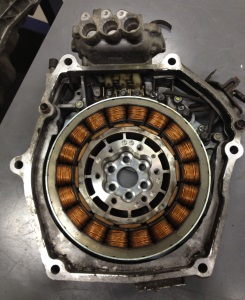Honda IMA Service and Repair
Honda IMA Service and Repair
Honda’s Integrated Motor Assist (IMA) has been in production for nearly 15 years and chances are you have had some of these vehicles in your bays already.
Dave Macholz/Motor Age — Entering the realm of hybrid repair can be a daunting venture for many technicians and shop owners. Servicing Honda Integrated Motor Assist (IMA) vehicles is a great way to get your feet wet, as the technology on these vehicles is intentionally not as evolved as competing manufacturers’ hybrid platforms. Understanding the system’s operation and recognizing service and repair concerns will help you in your quest to become a hybrid-capable repair technician or facility.

The IMA motor-generator is the heart of Honda’s IMA System.
Honda introduced its IMA system with the 1999 Insight and beat the competing Toyota Prius to the market by a margin of more than a year. Honda’s approach to the Hybrid Electric Vehicle (HEV) platform was to improve fuel economy by designing a lightweight, low-cost vehicle with an electrically assisted internal combustion engine (ICE). The IMA system utilizes a three-phase AC motor-generator (MG) sandwiched between the ICE and the CVT transmission.
This design is considered a simple or parallel hybrid and separates the IMA from its heavier Toyota counterpart that utilizes two motor-generators within a hybrid transaxle. The use of only one MG unit allows for the use of a fairly small HV battery, which also contributes to its weight reduction. The IMA has been used successfully in the Insight, Civic and Accord platforms, but because of increased EPA fuel economy demands, it will be replaced by a dual motor-generator hybrid drive, similar to Toyota’s Hybrid Synergy Drive system, in the 2014 Accord.
IMA Overview
Before you commit to servicing or repairing IMA vehicles, it is important to have a basic knowledge of system operation. The heart of the IMA system is a brushless three-phase AC motor-generator contained in a housing that bolts up between the ICE and the Constantly Variable (CVT) transmission. The rotor is a permanent magnet type that is bolted directly to the crankshaft, which means anytime the crankshaft turns, so does the rotor. The IMA motor provides power assist when needed, and also takes on the role of the conventional starter motor and alternator. The rotor includes a tone ring, and the IMA position sensor contained within the IMA housing monitors it.
Related stories from Motor Age:
- What’s New In Hybrid Systems?
- Cases of Batteries – Hybrid Battery Service
- Megohm Testing in Hybrid Vehicles
- Entering The Hybrid Service/Repair Market – The Trainer Video Series
Source: Motor Age

